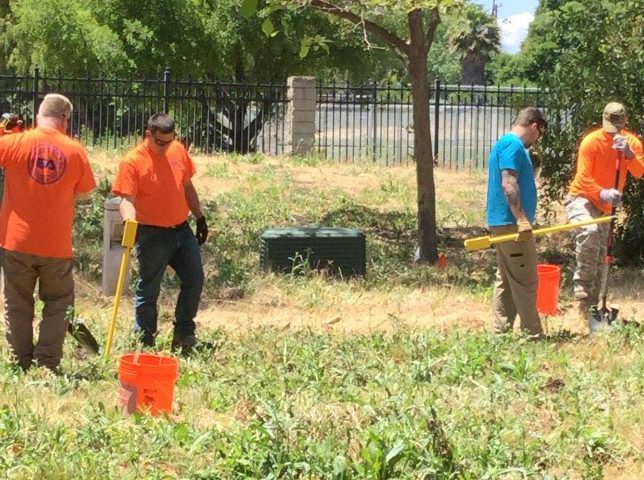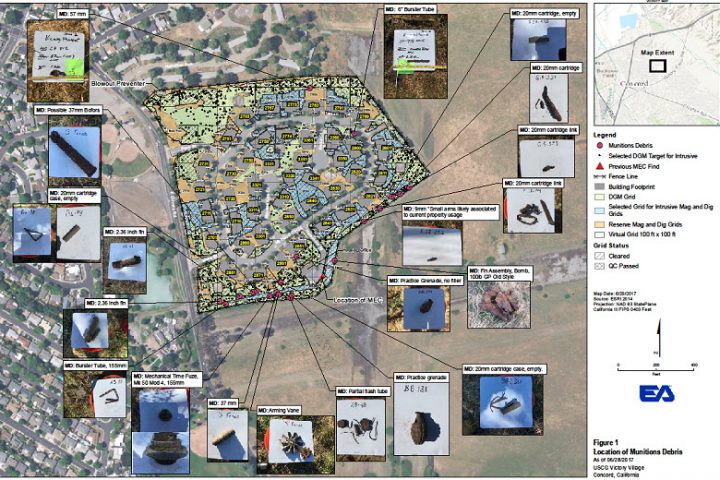 EA, under contract to the General Services Administration for the U.S. Coast Guard (USCG), performed a geophysical and intrusive investigation at the USCG Victory Village Housing Unit, Concord, California due to a historical find of munitions debris at the site. The primary objective of this investigation was to characterize and quantify surface and subsurface metallic anomalies over unpaved areas to determine if MEC are present at the property and whether follow-on remediation is necessary prior to the property being transferred/sold.
EA, under contract to the General Services Administration for the U.S. Coast Guard (USCG), performed a geophysical and intrusive investigation at the USCG Victory Village Housing Unit, Concord, California due to a historical find of munitions debris at the site. The primary objective of this investigation was to characterize and quantify surface and subsurface metallic anomalies over unpaved areas to determine if MEC are present at the property and whether follow-on remediation is necessary prior to the property being transferred/sold.
The Victory Village Housing Unit consisted of 27.48 acres adjacent to the Former Naval Weapons Station Concord. The property contained 206 USCG housing units situated within 43 buildings and an associated housing office building. For the purposes of this investigation, the 20-millimeter projectile was selected as the minimum geophysical target item of interest, as it is one of the more common projectiles used for training purposes and would have been used/stored at the Former Naval Weapons Station Concord.
 A DGM instrument verification strip was established at the site for daily testing of geophysical instrumentation including the EM61-MK2 sensor. Blind seeds were placed throughout the survey area to ensure detection capabilities were effective during field activities. Following a surface sweep and blind seeding, a DGM survey was performed over the accessible, unpaved areas on the property. Unpaved areas that were not accessible to DGM were intrusively investigated via “Mag and Dig” methods. A total of 3,284 Mag and Dig anomalies were investigated over 4.1 acres. Based on the DGM survey, 3,258 anomalies were identified as targets of interest based on the potential presence of 20-millimeter projectiles. Additionally, there were high anomaly density (i.e., saturated) areas identified within the DGM area that may be indicative of debris areas. A subset of DGM anomalies (683) were intrusively investigated and the types of items found included non-munitions related-debris (i.e., nails, wire, hand tools, pipe, sprinklers, rebar, hardware, and construction debris), and munitions debris that included various parts of high explosives and practice projectiles, bombs, and
A DGM instrument verification strip was established at the site for daily testing of geophysical instrumentation including the EM61-MK2 sensor. Blind seeds were placed throughout the survey area to ensure detection capabilities were effective during field activities. Following a surface sweep and blind seeding, a DGM survey was performed over the accessible, unpaved areas on the property. Unpaved areas that were not accessible to DGM were intrusively investigated via “Mag and Dig” methods. A total of 3,284 Mag and Dig anomalies were investigated over 4.1 acres. Based on the DGM survey, 3,258 anomalies were identified as targets of interest based on the potential presence of 20-millimeter projectiles. Additionally, there were high anomaly density (i.e., saturated) areas identified within the DGM area that may be indicative of debris areas. A subset of DGM anomalies (683) were intrusively investigated and the types of items found included non-munitions related-debris (i.e., nails, wire, hand tools, pipe, sprinklers, rebar, hardware, and construction debris), and munitions debris that included various parts of high explosives and practice projectiles, bombs, and  hand grenades. No MEC were found during the intrusive investigation. A total of 20 munitions debris items were found between 4 and 18 inches below ground surface. All munitions debris were inspected and certified as material documented as safe and was transferred offsite to a recycler for final disposition.
hand grenades. No MEC were found during the intrusive investigation. A total of 20 munitions debris items were found between 4 and 18 inches below ground surface. All munitions debris were inspected and certified as material documented as safe and was transferred offsite to a recycler for final disposition.
Based on a statistical analysis of the geophysical survey and intrusive results using Visual Sampling Plan statistical software, it was determined with 95 percent confidence that 99.95 percent of the remaining anomalies on the property are not MEC. The geophysical and intrusive investigation resulted in no identified MEC, further supporting the Visual Sampling Plan statistical analysis that demonstrates a very low probability that MEC are present on the property. EA has completed all tasks including a final report and the project has been accepted by the General Services Administration and USCG.
